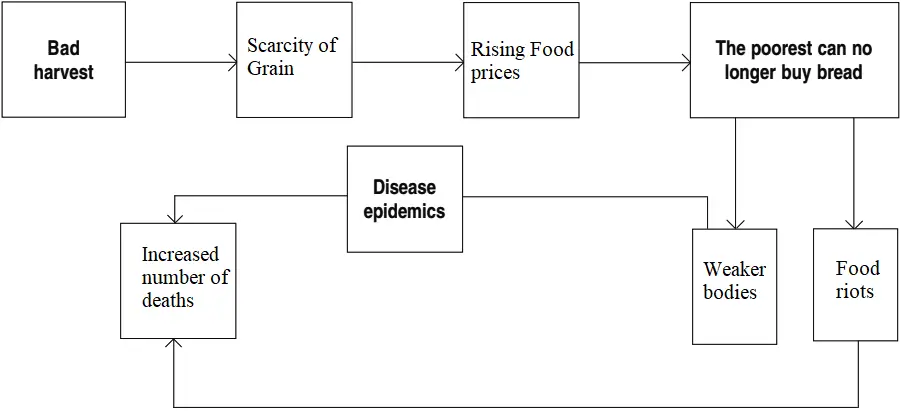NCERT Solution for Class 9 History Chapter 1 The French Revolution
Intext - Questions
Activity 1
Question.1. Explain why the artist has portrayed the nobleman as the spider and the peasant as the fly.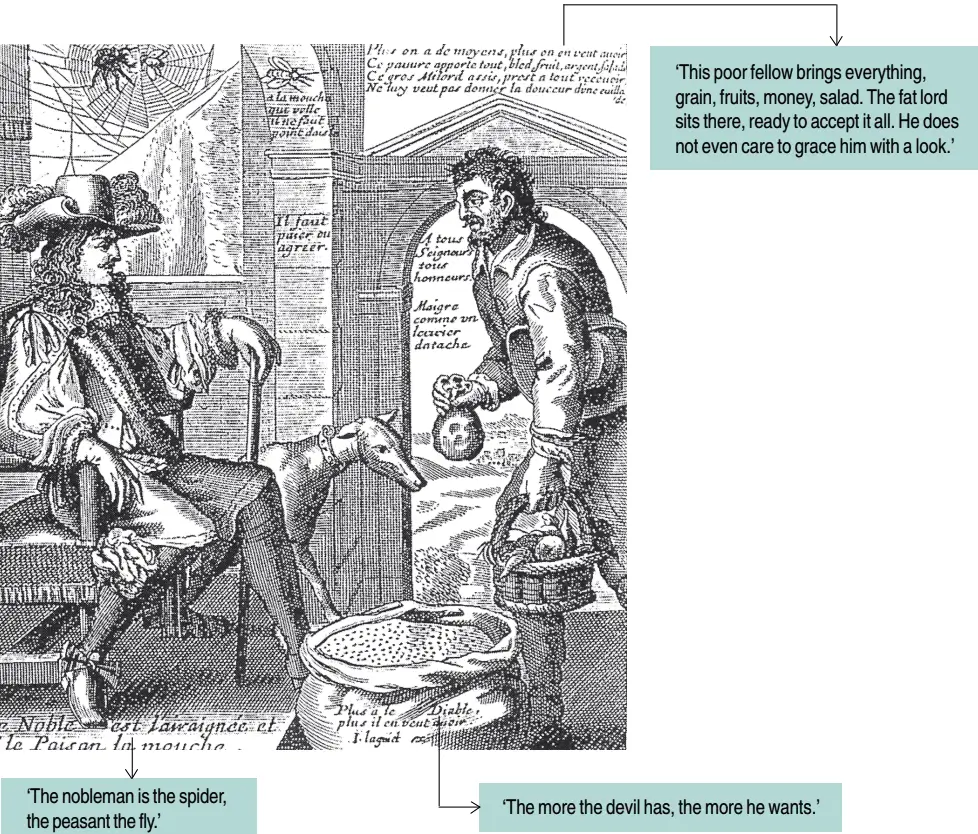
Activity 2
Question.1. Fill in the given blank box with appropriate terms from among the following: Food riots, scarcity of grain, increased number of deaths, rising food prices, weaker bodies.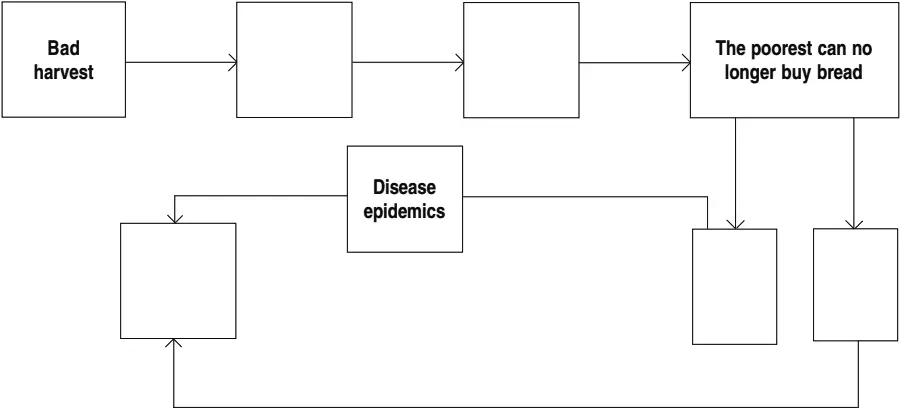
Activity 3
Question.1. What message is Young trying to convey here? Whom does he mean when he speaks of ‘‘slaves’’? Who is he criticizing? What dangers does he sense in the situation of 1787?
An Englishman, Arthur Young, travelled through France during the years from 1787 to 1789 and wrote detailed descriptions of his journeys. He often commented on what he saw.
‘He who decides to be served and waited upon by slaves, ill-treated slaves at that, must be fully aware that by doing so he is placing his property and his life in a situation which is very different from that he would be in, had he chosen the services of free and welltreated men. And he who chooses to dine to the accompaniment of his victims’ groans, should not complain if during a riot his daughter gets kidnapped or his son’s throat is slit.
Ans. Young is conveying the message that any social system based on Injustice will not last long and its consequences can be disastrous for the exploiters. The ‘slaves’ mentioned by him are the peasants, servants and landless sharecroppers, who were the underprivileged and deprived sections of French society at that time. He is criticizing the complete social system and particularly the noblemen and the clergy. The danger sensed by him is violence from the underprivileged sections on the noblemen and their families.
Activity 4
Question.1. Representatives of the Third Estate take the oath raising their arms in the direction of Bailly, the President of the Assembly, standing on a table in the centre. Do you think that during the actual event Bailly would have stood with his back to the assembled deputies? What could have been David’s intention in placing Bailly the way he has done?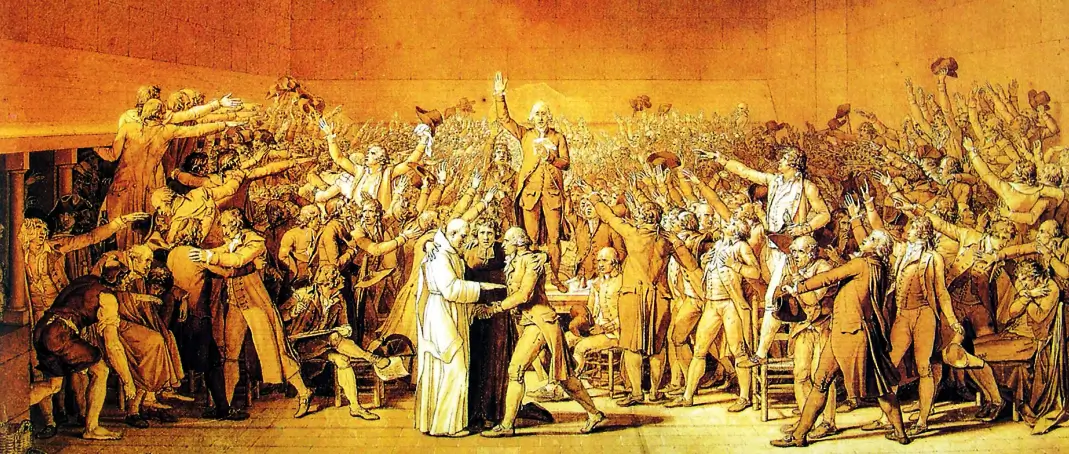
Activity 5
Question.1. Identify the symbols in Box 1 which stand for liberty, equality and fraternity.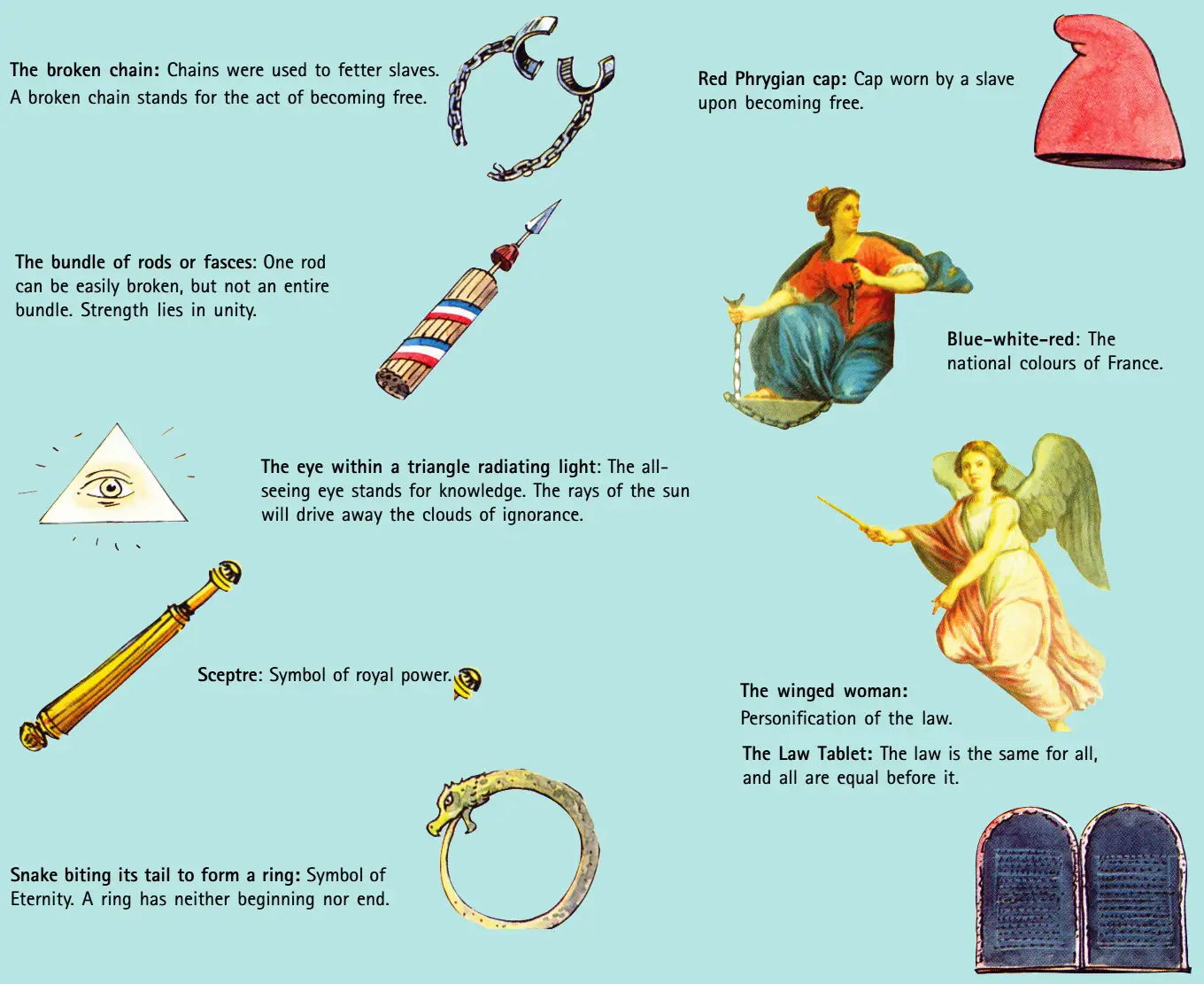
Liberty: The broken chain and the Red Phrygian cap.
Equality: The winged women and the Law tablet.
Fraternity: The bundle of rods or fasces and Blue-white-red.
Question.2. Explain the meaning of the painting of the Declaration of Rights of Man and Citizen by reading only the symbols.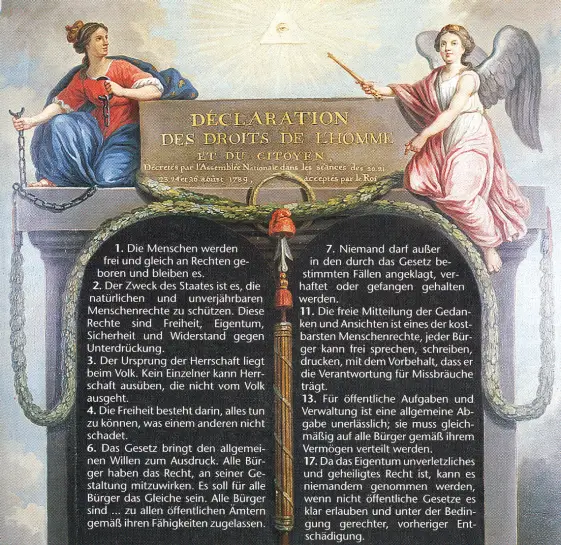
Question.3. Compare the political rights which the Constitution of 1791 gave to the citizens with Articles 1 and 6 of the Declaration (Source C). Are the two documents consistent? Do the two documents convey the same idea?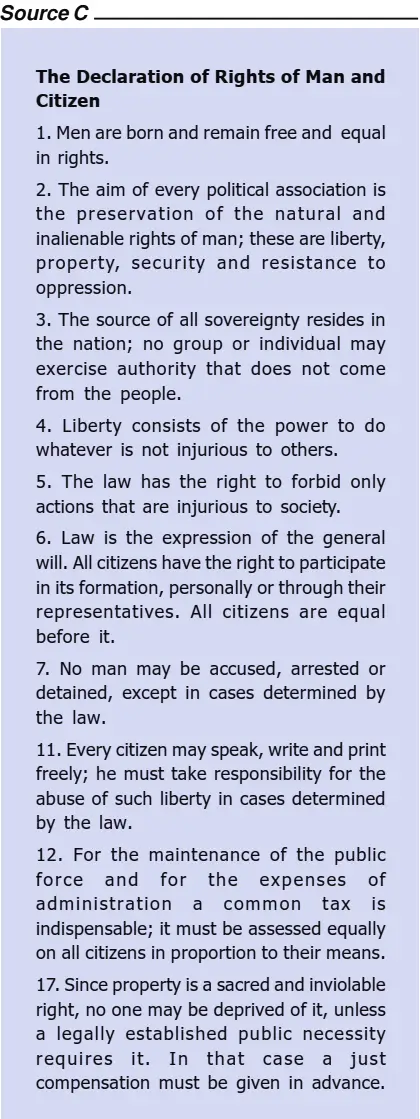
Question.4. Which groups of French society would have gained from the Constitution of 1791? Which groups would have had reason to be dissatisfied? What developments does Marat (Source B) anticipate in the future?
Question.5. Imagine the impact of the events in France on neighbouring countries such as Prussia, Austria-Hungary or Spain, all of which were absolute monarchies. How would the kings, traders, peasants, nobles or members of the clergy here, have reacted to the news of what was happening in France?
Ans. The kings, nobles, clergy and other privileged sections of these countries would become fearful that what has happened in France can happen in their country also. The peasants would welcome the developments in France and sympathies with the peasants and underprivileged sections of that country.
Activity 6
Question.1. Look carefully at the painting and identify the objects which are political symbols you saw in Box 1 (broken chain, red cap, fasces, Charter of the Declaration of Rights). The pyramid stands for equality, often represented by a triangle. Use the symbols to interpret the painting. Describe your impressions of the female figure of liberty.
Activity 7
Question.1. Compare the views of Desmoulins and Robespierre. How does each one understand the use of state force? What does Robespierre mean by ‘the war of liberty against tyranny’? How does Desmoulins perceive liberty? Refer once more to Source C. What did the constitutional laws on the rights of individuals lay -down? Discuss your views on the subject in class.
Robespierre saying, ‘the war of liberty against tyranny’ meant that they should kill the enemies of the republic both in France and outside France.
Desmoulins perceives liberty as laid down in the Declaration of Rights, i.e. it is happiness, reason, equality and justice. The constitutional laws on the rights of individuals laid down the rights of liberty, equality, property, security and resistance to oppression.
Activity 8
Question.1. Describe the persons represented in Fig. 12 – their actions, their postures, the objects they are carrying. Look carefully to see whether all of them come from the same social group. What symbols has the artist included in the image? What do they stand for? Do the actions of the women reflect traditional ideas of how women were expected to behave in public? What do you think: does the artist sympathize with the women’s activities or is he critical of them? Discuss your views in the class.
The drum symbolizes that they are proclaiming their march to all concerned. Here the actions of the women do not reflect the traditional ideas of how women should publicly behave. The artist definitely sympathizes with the activities of the women.
Activity 9
Question.1. Compare the manifesto drafted by Olympe de Gouges (Source F) with the Declaration of the Rights of Man and Citizen (Source C).
Activity 10
Question.10. Imagine yourself to be one of the women in Fig. 13. Formulate a response to the arguments put forward by Chaumette (Source G).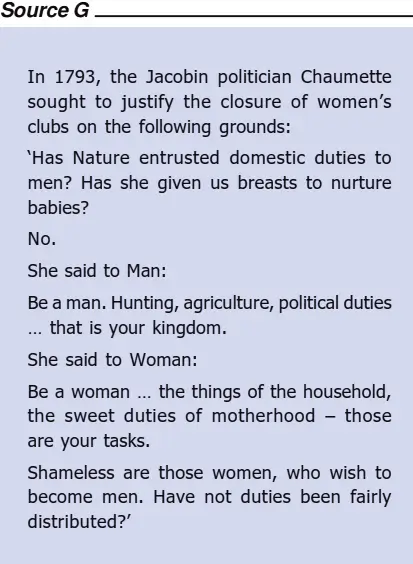
Activity 11
Question.1. Record your impressions of this print (Fig. 14). Describe the objects lying on the ground. What do they symbolize? What attitude does the picture express towards non-European slaves?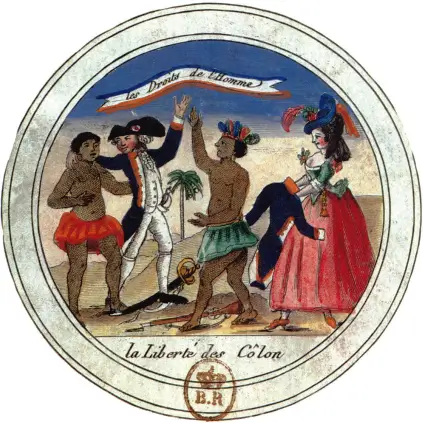
Activity 12
Question.1. Describe the picture in your own words. What are the images that the artist has used to communicate the following ideas: greed, equality, justice, takeover by the state of the assets of the church?
Ans. Greed is symbolized by the fat clergyman on the left. The two men accompanying him symbolize government officials who have taken over the assets of the Church. The fat reducing press in the middle symbolizes justice. The man and woman on the right symbolize equality. The whole picture depicts what the revolution stood for.
Activity 13
Question.1. Find out more about any one of the revolutionary figures you have read about in this chapter. Write a short biography of this person.
Ans. Napoleon Bonaparte:
The great Napoleon was born on 15th August 1769 to Carlo maria and Letizia Ramolino. He used to speak French and was very well educated. He led many successful campaigns against the enemies of the French revolution and crowned himself as an emperor of France. The Napoleon introduced many laws like the private property, uniform system of weights and also the measures provided by the decimal system. The armies of Napoleon were observed everywhere by the enemy force and finally defeated at Waterloo in 1815.
Question.2. The French Revolution saw the rise of newspapers describing the events of each day and week. Collect information and pictures on any one event and write a newspaper article. You could also conduct an imaginary interview with important personages such as Mirabeau, Olympe de Gouges or Robespierre. Work in groups of two or three. Each group could then put up their articles on a board to produce a wallpaper on the French Revolution.
Ans. Russian Revolution:
The Russian Revolution took place in the year 1917. It was one of the most explosive events of the 20th century. In 1917, two revolutions swept through Russia, ending centuries of imperial rule and setting into motion political and social changes that would lead to the formation of the Soviet Union.
While the two revolutionary events took place within a few short months, social unrest in Russia had been simmering for decades. In the early 1900s, Russia was one of the most impoverished countries in Europe with an enormous peasantry and a growing minority of poor industrial workers.
Students can conduct an imaginary interview at the presence of their History teacher and could use information from Library or Internet.
Exercise
Question.1. Describe the circumstances leading to the outbreak of revolutionary protest in France?
Ans. The following circumstances led to the outbreak of revolutionary protest in France:
- Louis XVI was an autocratic ruler who could not compromise with his luxurious life. He also lacked farsightedness.
- When he ascended the throne the royal treasury was empty. Long years of war had drained the financial resources of France. Added to this was the cost of maintaining an extravagant court at the immense palace of Versailles.
- Under Louis XVI France helped the thirteen American colonies to gain their independence from Britain the war added more than a billion lives to a dept credit, now began to charge 10% interest on loans. So the French government was obliged to spend an increasing percentage of its budget on interest payments alone.
- The state finally increased taxes to meet its regular expenses such as the cost of maintaining an army, running government offices and universities.
- The French society was divided into three estates but only members of the first two estates i.e; the clergy and the nobles were exempted to pay taxes. They belonged to the privileged classes. Thus the burden of financing activities of the state through taxes was borne by the third estate only.
- The middle class that emerged in the 18th century France was educated and enlightened. They refuted the theory of divine rights of the kings and absolute monarchy. They believed that a person’s social position must depend on his merit. They had access to the various ideas of equality and freedom proposed by philosophers like John Locke, Jean Jacques Rousseau, Montesquieu, etc. Their ideas got popularized among the common mass as a result of intensive discussions and debates in saloons and coffee houses and through books and newspapers.
- The French administration was extremely corrupt. It did not give importance to the French Common man.
The state finally increased taxes to meet its regular expenses such as the cost of maintaining an army, running government offices and universities.
Question.2. Which groups of French society benefited from the revolution? Which groups were forced to relinquish power? Which sections of society would have been disappointed with the outcome of the revolution?
Ans.
- The wealthy class of the third estate which came to be known as the new middle class of France benefited the most from the revolution. This group comprised of big businessmen, petty officers, lawyers, teachers, doctors and traders. Previously, these people had to pay state taxes and they did not enjoy equal status. But after the revolution they began to be treated equally with the upper sections of the society.
- With the abolition of feudal system of obligation and taxes, the clergy and the nobility came on the same level with the middle class. They were forced to give up their privileges. Their executive powers were also taken away from them.
- The poorer sections of the society, i.e. small peasants, landless laborers, servants, daily wage earners would have been disappointed with the outcome of the revolution. Women also would have been highly discontented.
Question.3. Describe the legacy of the French Revolution for the peoples of the world during the nineteenth and the twentieth centuries.
Ans. The French Revolution proved to be the most important event in the history of the world.
- The ideas of liberty and democratic rights were the most important legacy of the French Revolution. These ideas became an umpiring force for the political movements in the world in the 19th and 20th centuries.
- The ideas of liberty, equality and fraternity spread from France to the rest of Europe, where feudal system was finally abolished.
- Colonized people reworked on the idea of freedom from bondage into their movements to Create a sovereign nation state.
- The idea of Nationalism that emerged after the French Revolution started becoming mass movements all over the world. Now people began to question the absolute power.
- The impact of the French Revolution would be seen in India too. Tipu Sultan and Raja Ram Mohan Roy got deeply influenced by the ideas of the revolution. In the end, we can say that after the French Revolution people all over the world became aware of their rights.
Question.4. Draw up a list of democratic rights we enjoy today whose origins could be traced to the French Revolution.
Ans. Some of the democratic rights which we enjoy today can be traced to the French Revolution are as follows:
- Freedom of speech
- Freedom of expression
- Freedom of press
- Abolition of censorship
- Right to vote
- Abolition of slavery
- Right to liberty
- Right to property
- Right to security
- Right to education
- Divorce laws
Question.5. Would you agree with the view that the message of universal rights was beset with contradictions? Explain.
Ans.
- The message of universal rights was definitely beset with contradictions. Many ideals of the “Declaration of Rights of Man and Citizen” were not at all clear. They had dubious meanings.
- The French Revolution could not bring economic equality and it is the fact that unless there is economic equality, real equality cannot be received at any sphere. The Declaration of Rights of Man and Citizen laid stress on equality but large section of the society was denied to it. The right to vote and elect their representatives did not solve the poor man’s problem.
- Women were still regarded as passive citizens. They did not have any political rights such as right to vote and hold political offices like men. Hence, their struggle for equal political rights continued.
- France continued to hold and expand colonies. Thus, its image as a liberator could not last for a long time.
Slavery existed in France till the first half of the 19th century.
Question.6. How would you explain the rise of Napoleon?
Ans.
- The political instability of the Directory paved the way for the rise of Napoleon Bonaparte Napoleon had achieved glorious victories in wars. This made France realize that only a military dictator like Napoleon would restore a stable government.
- In 1804, he crowned himself the emperor of France. He set out to conquer neighbouring European countries, dispossessing dynasties and creating kingdoms where he placed members of his family. Napoleon viewed himself as a Modernizer of Europe.
- He introduced many laws such as the protection of private property and a uniform system of weight and measures provided by the decimal system. But his rise to power did not last for a long time. He was finally defeated at Waterloo in 1815.


